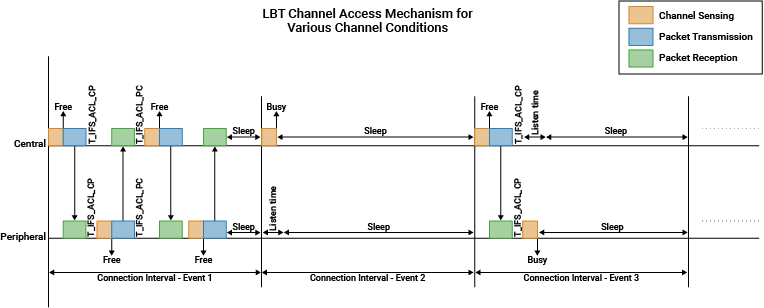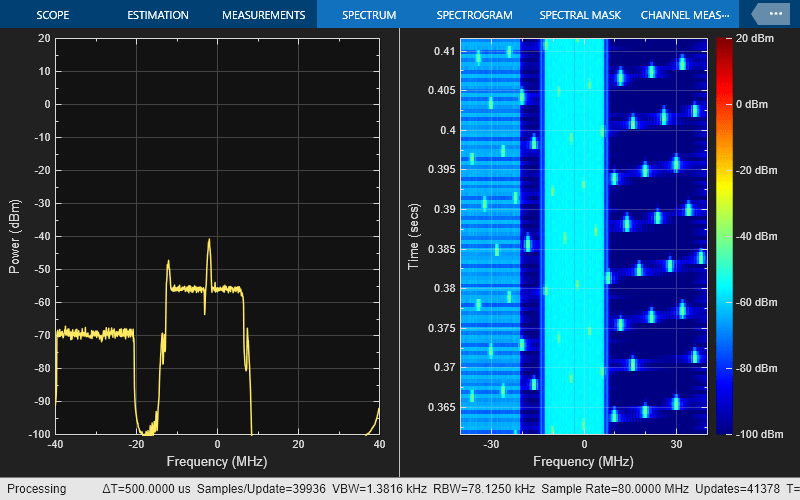Coexistence Modeling
Bluetooth® Toolbox features and reference examples enable you to evaluate the performance of Bluetooth basic rate/enhanced data rate (BR/EDR) and low energy (LE) systems in the presence of WLAN and New Radio (NR) signal interference.
Use the coexistence modeling capabilities of the toolbox to:
Simulate Bluetooth LE in 6 GHz supporting channel access mechanisms such as listen before talk (LBT), spectrum sensing based deferral (SSBD), and detect and avoid (DAA).
Create and configure a shared wireless channel between Bluetooth and WLAN.
Simulate and visualize noncollaborative coexistence between Bluetooth and WLAN and mitigate interference by using adaptive frequency hopping (AFH).
Simulate and visualize collaborative coexistence between Bluetooth and WLAN by using PHY packet traffic arbitration (PTA).
Configure Bluetooth channels for LE connections, LE Audio, LE advertisement, and BR/EDR connections.
Measure key performance indicators (KPIs) such as throughput, latency, packet delivery ratio (PDR), and packet loss ratio (PLR) at both the node and network levels to analyze the network and the effect of interference.
To use the network simulation functionality for modeling Bluetooth and WLAN coexistence, install the Communications Toolbox Wireless Network Simulation Library add-on.

Functions
addMobility | Add random waypoint mobility model to Bluetooth LE node (Since R2023b) |
kpi | Returns key performance indicators (KPIs) for Bluetooth LE nodes (Since R2024b) |
addTrafficSource | Add data traffic source to Bluetooth LE node (Since R2022a) |
configureConnection | Configure LL connection between Bluetooth LE Central and Peripheral nodes (Since R2022a) |
configureScheduler | Configure baseband scheduler at Bluetooth BR/EDR Central node (Since R2023a) |
statistics | Get statistics of Bluetooth LE node (Since R2022a) |
Objects
wirelessNetworkSimulator | Wireless network simulator (Since R2022b) |
bluetoothLENode | Bluetooth LE node (Since R2022a) |
bluetoothNode | Bluetooth BR/EDR node (Since R2022b) |
bluetoothLEConnectionConfig | Bluetooth LE LL connection configuration parameters (Since R2022a) |
bluetoothConnectionConfig | Bluetooth BR/EDR connection configuration parameters (Since R2022b) |
bleChannelSelection | Bluetooth LE channel index selection |
bluetoothFrequencyHop | Bluetooth BR/EDR channel index for frequency hopping |
networkTrafficOnOff | On-Off application traffic pattern generator (Since R2022a) |
Topics
- Bluetooth-WLAN Coexistence
Understand the coexistence of Bluetooth and WLAN.
- Wireless Network Simulator
Learn how the wireless network simulator object works.
- Composition of Bluetooth BR/EDR Node
Learn about the composition of a Bluetooth BR/EDR node.
- Composition of Bluetooth LE Node
Learn about the composition of a Bluetooth LE Node.
- Bluetooth LE Node Statistics
Explore the statistics of a Bluetooth LE node.
- Bluetooth BR/EDR Node Statistics
Explore the statistics of a Bluetooth BR node.
- Create, Configure, and Simulate Bluetooth BR/EDR Piconet
Use Bluetooth node creation and wireless network simulation capabilities to create, configure, and simulate a Bluetooth BR piconet.
- Simulate Multiple Bluetooth BR/EDR Piconets with ACL Traffic
Use Bluetooth node creation and wireless network simulation capabilities to create, configure, and simulate multiple Bluetooth BR piconets with ACL traffic.







